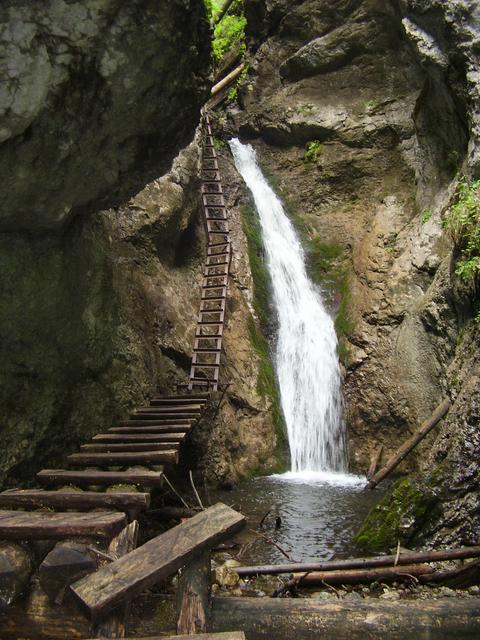Slovak Paradise National Park (Národný park Slovenský Raj) is a mountain range in Eastern Slovakia.

It lies between the towns of Spišská Nová Ves in the north and Dobšiná in the south. It is particularly known for its gorges and waterfalls.
Forests cover 90% of the park, and there are over 900 species of plants.
Brown bear, golden eagle and black stork live here, as do more common red deer and wild boars, and wolves.
You need to obtain a permit on entrance to the national park. These cost €1.50 for 1 day, €3.50 for 3 days and €5 for 6 days, multi day permits are only valid for consecutive dates.
- Dobšinská Ľadová Jaskyňa. Listed on the UNESCO World Heritage list as part of caves of Slovak Karst. First European cave to be electrically lit, in 1887. From a total of ~1200m of caves, about a 475m-long circuit is accessible.
- Kláštorisko. Archeological site with ruins of the Carthusian monastery. The only tourist center inside the park, with restaurant and housings.
Dobšinská Ľadová Jaskyňa. Listed on the [[UNESCO World Heritage]] list as part of caves of Slovak Karst. First European cave to be electrically lit, in 1887. From a total of ~1200m of caves, about a 475m-long circuit is accessible.
Kláštorisko. Archeological site with ruins of the Carthusian monastery. The only tourist center inside the park, with restaurant and housings.
It is very popular with hikers as it has a number of unusual routes through gorges and waterfalls. There are numerous sections where fixed ladders are used to climb.
- Dolina Kyseľ / Ferrata HZS. 1.5-km long ravine, ferrata equipment mandatory. Equipment can be hired from various shops and restaurants in Pila, Podlesok and from Turisticky Raj at the western end of Prielom Hornadu. Gear can also be hired from the cycle hire facility at Klastorisko although they only have a very small amount of gear available, you need to get to the summit early if planning on hiring from here, gear is also cheaper in the villages. We arrived at the summit at around 1230 (admittedly on a bank holiday Friday) and found that it was too late. You will need to purchase a €5 ticket (available from shops which hire out gear) to enter the Ferrata. This is not available at the Ferrata although a sign at 48.93750 20.42803 provides instructions for how to pay by SMS.
- Suchá Belá. A crossing of paths in the park
- Veľký Kyseľ. One of the wildest ravines in the park, with many waterfalls.
- Malý Kyseľ. 2-km long ravine alongside a stream, with ladders etc., Only going uphill possible.
- Kláštorská roklina. One of the most visited ravines, 1.5-km long, only possible to go uphill. 13-m waterfall on the path, many ladders on the way.
Dolina Kyseľ / Ferrata HZS. 1.5-km long ravine, ferrata equipment mandatory. Equipment can be hired from various shops and restaurants in Pila, Podlesok and from Turisticky Raj at the western end of Prielom Hornadu. Gear can also be hired from the cycle hire facility at Klastorisko although they only have a very small amount of gear available, you need to get to the summit early if planning on hiring from here, gear is also cheaper in the villages. We arrived at the summit at around 1230 (admittedly on a bank holiday Friday) and found that it was too late. You will need to purchase a €5 ticket (available from shops which hire out gear) to enter the Ferrata. This is not available at the Ferrata although a sign at 48.93750 20.42803 provides instructions for how to pay by SMS.
Suchá Belá. A crossing of paths in the park
Veľký Kyseľ. One of the wildest ravines in the park, with many waterfalls.
Malý Kyseľ. 2-km long ravine alongside a stream, with ladders etc., Only going uphill possible.
Kláštorská roklina. One of the most visited ravines, 1.5-km long, only possible to go uphill. 13-m waterfall on the path, many ladders on the way.
There are multiple restaurants located in Podlesok just South of the car parks.
The restaurant at Klastorisko closed at the end of the summer 2018 season, as of early July 2019 no food or drinks where available here.
- Slovak Karst
- Low Tatras
